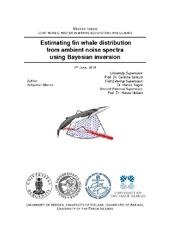Estimating fin whale distribution from ambient noise spectra using Bayesian inversion
Master thesis
Permanent lenke
https://hdl.handle.net/1956/10323Utgivelsesdato
2015-06-01Metadata
Vis full innførselSamlinger
- Geophysical Institute [1198]
Sammendrag
Passive acoustic monitoring is increasingly used to study the distribution and migration of marine mammals. Marine mammal vocalizations are transient sounds, but the combined sound energy of a population continuously repeating a vocalization, adds up to a quasi-continuous chorus. Marine mammal choruses can be identified as peaks in ocean ambient noise spectra. In the North Atlantic, the fin whale chorus is commonly observed as peak at 20 Hz. This thesis proposes a method to estimate the distribution of vocalizing fin whales based on a set of fin whale chorus recordings. This is an extremely under-determined inverse problem. The method is based on Bayesian inverse theory and uses simulated annealing to estimate the most likely distribution of sound sources (vocalizing whales) on a geodesic grid. This includes calculating a transmission loss matrix connecting all grid nodes and recorders, using an arbitrary sound propagation model. Two models were successfully implemented: geometrical spreading and the ray trace model BELLHOP. The inversion method was tested under different scenarios. The results indicated that an imprecise transmission loss matrix is tolerated by the inversion method. The accuracy of the method depended mainly on the number and distribution of recorders. For the Norwegian sea, simulations showed that fin whale chorus inversion is possible using as few as 12 recorders between Iceland and Svalbard. An inversion based on data from published fin whale chorus observations indicated realistic winter distribution patterns. Existing methods to study marine mammal distribution are often confined to the summer months and a limited area. Future application of the proposed method admits automatic year-round monitoring of marine mammal distribution on a basin-wide scale.
